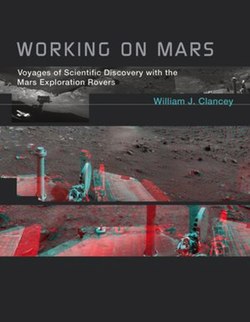Review: Working on Marsby Jeff Foust
|
| Clancey was an observer in the early days of the MER mission, sitting in on meetings as the science team planned the activities of the twin rovers. |
The Curiosity team is, from an operational sense, following in the footsteps (tire tracks?) of NASA’s Mars Exploration Rovers (MER) mission. Spirit and Opportunity landed on Mars in January 2004 for what were planned to be 90-day missions; both long exceeded that goal, and Opportunity continues working today (if overshadowed a bit now by the arrival of the new-and-improved Curiosity). In addition to the science these rovers performed, the mission also provided lessons on how to run such a mission and even insights regarding what it means to explore, all topics examined in William Clancey’s book Working on Mars.
Clancey, the chief scientist of the Human-Centered Computing group at NASA’s Ames Research Center, was an observer in the early days of the MER mission, sitting in on meetings as the science team planned the activities of the twin rovers. The book is about the insights he gained from those observations, plus later interviews with scientists and engineers involved in the project, about the similarities and differences between conventional field geology on Earth and what Spirit and Opportunity—often billed as “robot geologists”—were doing on Mars under the guidance of the project team back on Earth.
While it’s tempting to consider Spirit and Opportunity as something like a terrestrial, human field geologist, Clancey notes there are some major differences. On Earth, geologists work in the field alone or in small groups, quickly going across the terrain looking for something interesting. The operations of the MERs, by contrast, were controlled by a team of dozens of scientists, meeting daily to discuss the latest findings and plans for the next day’s work. In addition, those on the MER team with experience as field geologists would sometimes get impatient with the slow pace of the rovers, noting they could cover the ground a rover did on a good day in minutes. Yet no geologist had the patience to hold an instrument in place over a rock for hours to get data, as Spirit and Opportunity routinely did.
Clancey, while a computer scientist, is in Working on Mars more of an anthropologist at times, comparing and contrasting the people working on the mission. There are the differences between the scientists using the rovers to study Mars and the engineers who built and operate the rovers, roles that can lead to conflict but also cooperation, as he notes. There’s also differences within the science team, particularly between those whose background is working in the field and those who primarily work in the lab. The former often wanted to quickly move on to the next destination, while the latter often wanted to linger and perform more observations with their instruments.
| Clancey, while a computer scientist, is in Working on Mars more of an anthropologist at times, comparing and contrasting the people working on the mission. |
Clancey even delves into the nature of “exploration” itself: what does exploration mean, particularly in the context of this mission, which has exploration in its name? He argues that MER was doing “scientific exploration” as first described by 18th century explorer Alexander von Humboldt, which sought to go beyond simply observing to more methodically, scientifically recording data in a systematic way. This is supported by Clancey’s observations of the MER science team meetings, where members who proposed a particular observation, like taking an image or collecting a spectrum, had to explain what hypothesis that observation would answer.
The lessons of MER, particularly in the interactions among team members, have presumably transferred over to the Curiosity team. (One likely difference is the time pressure the MER teams felt: some described having a “sniper mentality” because, with a prime mission of only 90 days, they worried the rovers could die at any time. Curiosity, though, has a prime mission of at least two years.) Working on Mars provides an enlightening look at running a robotic exploration mission like Spirit and Opportunity—and now Curiosity—and its implications for the future of space exploration itself.
